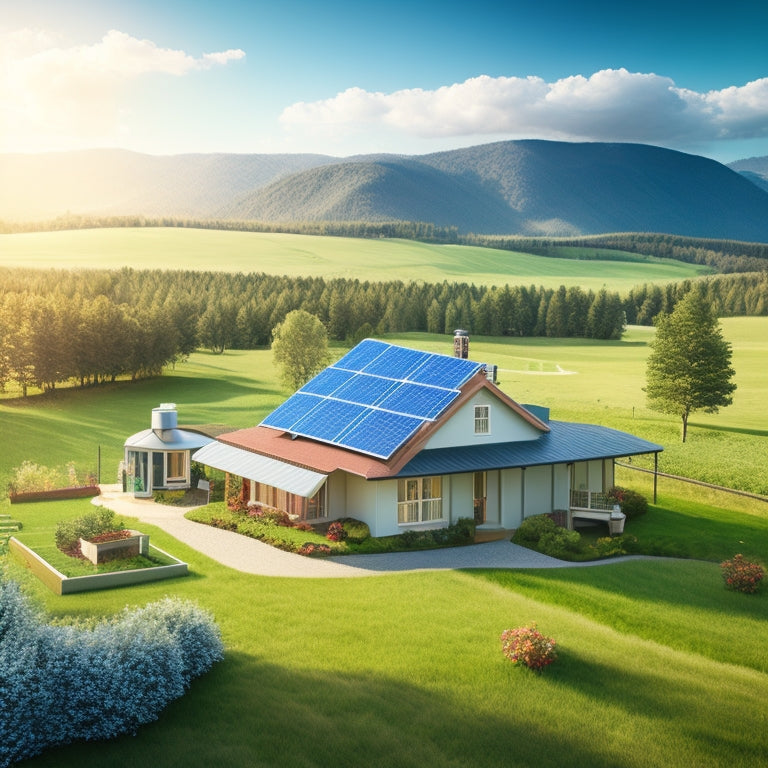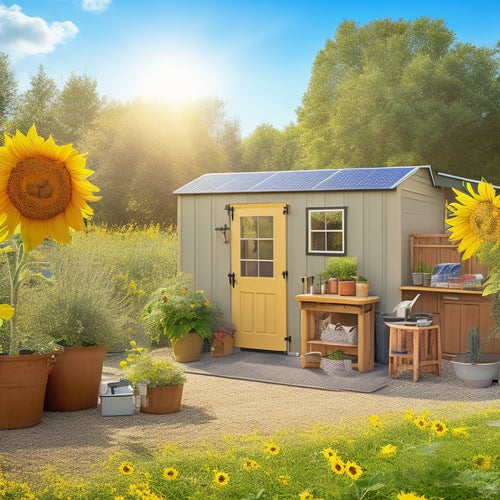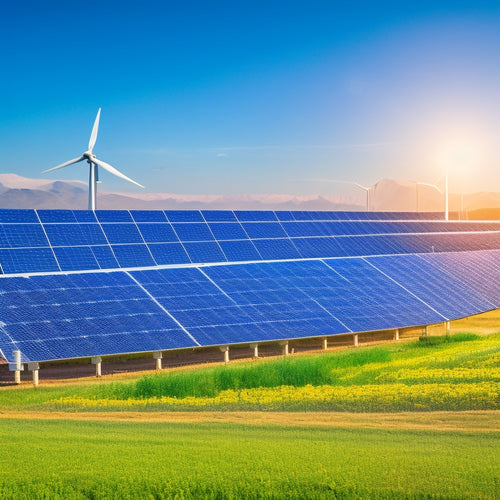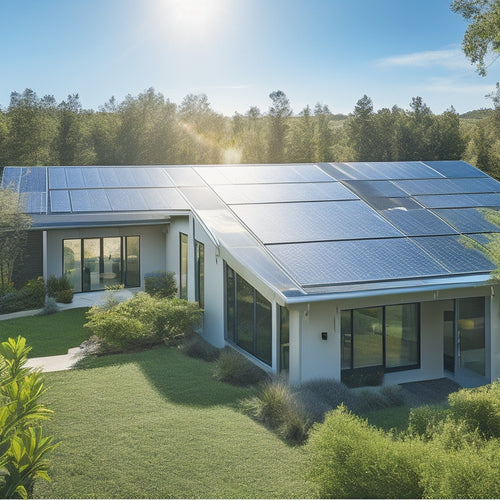
What Makes a Complete Renewable Energy Kit?
Share
You're building a renewable energy kit, but what makes it complete? It starts with the right components: a charge controller to regulate energy flow, a deep cycle battery for efficient storage, an inverter to convert DC to AC power, a mounting system to support your solar panels, and a tracking device to optimize their angle. But that's not all - you'll also need to choose high-quality solar panels, select the right battery type and size, and consider inverter technology and efficiency. And don't forget to think about monitoring and control systems, safety features, and certifications - the more you understand these elements, the more you'll be able to utilize the full potential of your kit.
Overview
- A complete renewable energy kit includes a charge controller to regulate energy flow from solar panels to batteries.
- High-quality solar panels with high efficiency, long lifespan, and durability are essential for optimal energy production.
- A suitable battery selection and sizing, considering factors like voltage, type, and cost, is crucial for efficient energy storage.
- An inverter with high efficiency and a proven track record is necessary to convert DC power to AC power for household use.
- A comprehensive monitoring and control system enables real-time performance tracking, efficiency optimization, and remote system access.
Key Components of a Kit
In conjunction with an extensive understanding of renewable energy systems, a complete renewable energy kit comprises several key components.
You'll need a reliable charge controller to regulate energy flow, a deep cycle battery for efficient energy storage, and an inverter to convert DC power to AC.
Additionally, a mounting system and tracking device are essential for ideal solar panel performance.
When designing your kit, consider the unique demands of your location, such as high temperatures or extreme weather conditions.
High-efficiency panels and durable mounting systems DIY Solar Kits can guarantee maximum energy output.
Follow installation tips like securing components to a stable structure and guaranteeing proper ventilation to assure a safe and efficient system.
Solar Panel Quality Matters
Selecting high-quality solar panels is essential to verify your renewable energy kit operates at its maximum potential. When choosing solar panels, you want to ascertain you're getting the best performance for your investment. Two critical factors to evaluate are solar efficiency and panel lifespan.
| Factor | What to Look For |
|---|---|
| Solar Efficiency | Look for panels with high efficiencies (above 20%) to maximize energy production. |
| Panel Lifespan | Choose panels with a warranty of at least 25 years to guarantee long-term performance. |
| Durability | Select panels with anodized aluminum frames and tempered glass for added strength. |
| Certifications | Verify panels meet industry standards, such as UL and IEC certifications. |
| Manufacturer Reputation | Research the manufacturer's reputation for producing high-quality, reliable panels. |
Battery Selection and Sizing
You'll need to choose the right battery type, considering options like lead-acid, lithium-ion, and saltwater batteries, each with its own strengths and weaknesses.
Deep cycle batteries, designed for renewable energy systems, offer benefits like longer lifetimes and higher depths of discharge, and are ideal for solar applications due to their ability to provide a consistent energy supply over extended periods energy storage and efficiency.
They can withstand the rigors of frequent use and are built for repeated charging and discharging.
When selecting a battery, you'll also need to decide on a system voltage, typically 12V, 24V, or 48V, which will impact your overall system design and component compatibility.
Battery Type Options
As your renewable energy system's storage backbone, batteries play a critical role in ensuring a reliable and efficient supply of power.
When choosing a battery type, you'll likely come across lithium and lead acid options. Lithium batteries offer several advantages, including higher energy density, longer lifespan, and lower self-discharge rates. Additionally, deep cycle batteries like Rolls Deep Cycle Batteries can provide up to 5,000 cycles at 50% DOD, making them a reliable option Battery Management Systems.
On the other hand, lead acid batteries have some drawbacks, such as lower energy density, heavier weights, and shorter lifespans. You'll want to take into account these factors when selecting the right battery for your system.
Lithium batteries may be more expensive upfront, but their longer lifespan and higher efficiency can save you money in the long run. By choosing the right battery type, you'll be one step closer to achieving energy independence.
Deep Cycle Benefits
Your renewable energy system's performance hinges on the correct battery selection and sizing, and deep cycle batteries offer several benefits that make them an attractive choice.
By choosing deep cycle batteries, you'll enjoy longer battery lifespan, as they're designed to withstand the demands of daily charging and discharging. This means you'll replace them less often, saving you money and reducing waste.
Deep cycle advantages also include a more stable voltage, which guarantees your system runs smoothly and efficiently.
Additionally, deep cycle batteries are built to handle the fluctuations in energy production that come with renewable energy sources, making them an ideal choice for your off-grid energy system.
System Voltage Choice
Selecting the ideal system voltage is a critical aspect of designing a complete renewable energy kit, since it directly impacts the performance and efficiency of your off-grid energy system. You need to verify system compatibility by choosing a voltage that aligns with your battery bank, inverter, and charge controller. Voltage considerations include the type and number of batteries, wiring requirements, and the overall system design.
| System Voltage | Advantages | Disadvantages |
|---|---|---|
| 12V | Simple wiring, low cost | Limited power capacity, heavy cables |
| 24V | Balanced power and wiring | More complex system design |
| 48V | High power capacity, efficient | Higher cost, specialized components |
When selecting a system voltage, consider your energy needs, budget, and the components you've chosen for your renewable energy kit. A well-designed system voltage guarantees peak performance, efficiency, and reliability.
Inverter Technology and Efficiency
The heart of any renewable energy system lies in its inverter technology, which efficiently converts DC power from solar panels or wind turbines into AC power for homes, businesses, and industries.
You need an inverter that can seamlessly integrate with the grid, ensuring a smooth flow of energy. Look for inverters with high efficiency ratings (usually above 95%) to minimize energy losses.
A longer inverter lifespan is also essential, as it directly impacts the overall system's reliability and durability. When selecting an inverter, consider one with a proven track record of reliability, high-quality components, and an extensive warranty.
This will give you peace of mind, knowing your system will perform effectively for years to come.
Mounting and Tracking Systems
With high-efficiency inverters in place, it's time to focus on the physical components that secure and optimize your renewable energy system's performance.
You'll need mounting materials that can withstand various environmental conditions and support the weight of your panels or turbines. Choose durable materials like anodized aluminum or stainless steel that can resist corrosion and last for decades.
Tracking mechanisms also play a vital role in maximizing energy output. Single-axis or dual-axis trackers can adjust the angle and orientation of your panels to capture more sunlight throughout the day.
Monitoring and Control Systems
You'll need a monitoring and control system to optimize your renewable energy kit's performance.
This system will consist of data acquisition systems that collect and store data on your kit's output, allowing you to track its real-time performance and identify areas for improvement.
With remote system access, you'll be able to monitor and control your kit from anywhere, ensuring maximum efficiency and minimizing downtime.
Data Acquisition Systems
Real-time monitoring and control systems are the backbone of a reliable and efficient renewable energy setup, and data acquisition systems are the essential component that enables this functionality.
You need a data acquisition system that can collect and process data from various sensors and devices, providing you with important observations into your renewable energy system's performance.
This system should be capable of data logging, allowing you to track performance trends and identify areas for improvement.
Sensor integration is also vital, as it enables the system to gather data from a wide range of sensors, including temperature, voltage, and current sensors.
With a strong data acquisition system, you'll have the data you need to optimize your renewable energy setup and achieve energy independence.
Real-time Performance Tracking
Your data acquisition system provides a wealth of information, but it's only half the battle. You need a way to analyze and act on that data in real-time to optimize your renewable energy system's performance.
This is where real-time performance tracking comes in. With a monitoring and control system, you can receive instant notifications of any issues, ensuring prompt troubleshooting and minimizing downtime.
Real-time analytics enable you to identify areas for improvement, making data-driven decisions to optimize performance and maximize energy production.
By tracking your system's performance in real-time, you can fine-tune your setup, reduce energy losses, and increase your return on investment.
This level of control and visibility is essential for achieving energy independence and maximizing the benefits of your renewable energy system.
Remote System Access
The command center of your renewable energy system is now at your fingertips, thanks to remote system access.
With remote diagnostics, you can troubleshoot issues and identify potential problems before they become major setbacks. This feature allows you to perform routine maintenance and repairs from the comfort of your own home, or even on-the-go.
Through a user-friendly interface, you'll have real-time access to your system's performance data, enabling you to make informed decisions about your energy usage.
This level of control and autonomy is what freedom in energy production is all about. With remote system access, you're in the driver's seat, making it easy to optimize your system's performance and maximize your energy independence.
Safety Features and Certifications
Three key aspects of the Complete Renewable Energy Kit's design prioritize user safety: electrical protection, mechanical safeguards, and compliance with industry standards.
You can rest confident that your system is designed to prevent electrical shock, fire hazards, and other potential risks. The kit's electrical protection features include overcurrent protection, overvoltage protection, and grounding systems to guarantee safe operation.
Mechanical safeguards, such as secure mounting and weather-resistant enclosures, protect the system from environmental hazards.
In addition, the kit meets or exceeds industry standards for fire safety, emergency protocols, and other critical safety considerations.
This means you can enjoy the freedom and independence of renewable energy while minimizing risks to yourself and others.
Frequently Asked Questions
Can I Customize a Renewable Energy Kit for My Specific Needs?
You can tailor a renewable energy kit to your specific needs by considering your energy requirements and customizing the kit's components to guarantee a perfect fit, allowing you to maximize energy independence and minimize waste.
How Long Does It Take to Install a Complete Renewable Energy Kit?
You'll spend around 2-5 days installing a complete renewable energy kit, depending on the complexity of the system and the number of kit components, such as solar panels, inverters, and mounting hardware, that need to be configured and connected.
Are Renewable Energy Kits Suitable for Homes With Limited Roof Space?
You're concerned about limited roof space, but don't worry, you can still go off-grid with compact, high-efficiency solutions that maximize energy production in small areas, ensuring a reliable, self-sufficient energy supply for your home.
Can I Expand My Renewable Energy Kit in the Future if Needed?
You'll have peace of mind knowing you can expand your renewable energy kit in the future if needed, thanks to modular designs offering easy future upgrades and flexible expansion options that adapt to your growing energy demands.
Do Renewable Energy Kits Come With Warranties or Maintenance Plans?
Did you know 75% of homeowners consider warranty coverage essential when investing in renewable energy? You'll be relieved to know most kits come with warranties, often including maintenance services, giving you peace of mind and protecting your investment in the long run.
Ready to Buy
As you flip the switch on your renewable energy kit, you're catapulted into a futuristic world where fossil fuels are a distant memory. But, don't get ahead of yourself - a complete kit requires careful consideration of each component. You've got the solar panels capturing the sun's energy, a beefy battery storing the juice, an inverter converting it to usable power, a tracking system maximizing output, and a monitoring system keeping tabs on performance. With these pieces in place, you're ready to join the renewable revolution!
Related Posts
-

Building an Emergency Backup Solar Power System in 5 Essential Steps
Building an emergency backup solar power system involves five key steps. First, assess your daily energy needs to ide...
-

The Role of Battery Monitoring Systems in Renewable Energy
Battery monitoring systems play an essential role in renewable energy by enhancing system longevity and optimizing pe...
-

Installing Metal Solar Roofs for Maximum Energy Efficiency
Installing metal solar roofs can drastically enhance your home's energy efficiency and durability. These roofs withst...


